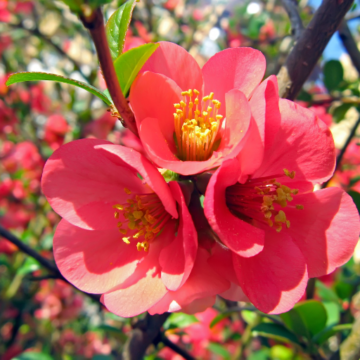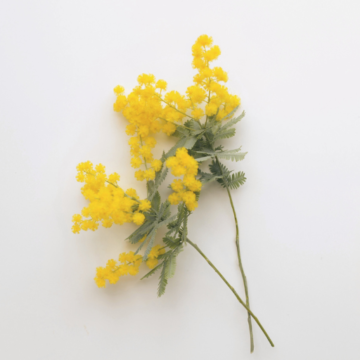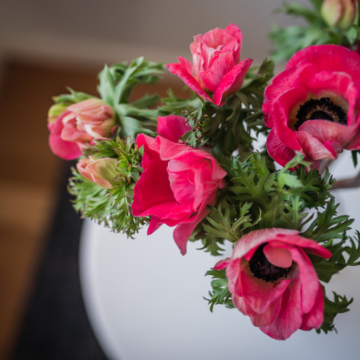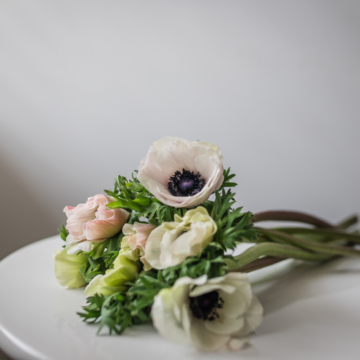Nature never ceases to amaze us with its vast array of captivating and exquisite creations. Among these wonders is Chaenomeles speciosa, a flowering plant that captures us with its vibrant blossoms and captivating fragrance.
Chaenomeles speciosa, commonly known as japonica and the flowering quince, belongs to the Rosaceae family. The genus name “Chaenomeles” is derived from the Greek words “chaínein,” meaning “to yawn,” and “mēlon,” meaning “apple.” This name refers to the open fruit resembling a gaping mouth. “Speciosa” originates from the Latin term for “showy” or “beautiful,” perfectly describing the plant’s stunning appearance.

Chaenomeles speciosa has a rich cultural history. Originating in East Asia, particularly China and Japan, it holds deep symbolism in these countries. In Chinese culture, the flowering quince symbolises good luck, prosperity and beauty. The vibrant blooms are often depicted in traditional paintings and used during celebrations like the Lunar New Year. In Japan, Chaenomeles speciosa represents strength, vitality and perseverance. Furthermore, in some cultures, Chaenomeles speciosa is believed to bring good luck and ward off evil spirits.
Apart from its visual appeal, Chaenomeles speciosa offers various therapeutic benefits. Traditional medicine practitioners have long utilised its medicinal properties. The fruit of the flowering quince contains high levels of vitamin C, antioxidants and other beneficial compounds. It is believed to boost the immune system, aid digestion and promote healthy skin. https://www.ncbi.nlm.nih.gov/pmc/articles/PMC3917013/#:~:text=speciosa%2C%20which%20is%20warm%20in,beriberi%2C%20vitamin%20C%20deficiency%20syndrome%2C
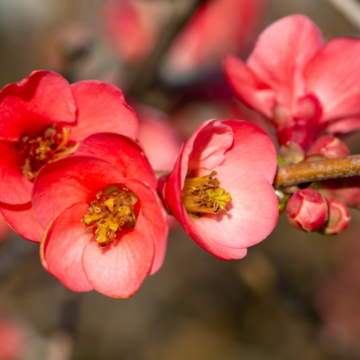
Mugua is a traditional Chinese medicine made from the fruits of different Chaenomeles plants. This fruit is pretty versatile and has many benefits. It can relieve pain, reduce inflammation, fight germs and is rich in antioxidants. It also helps relax muscles, tightens things up, aids digestion and can even lower blood sugar levels. People make a decoction from it to treat various conditions like nausea, joint pains, rheumatoid arthritis, hepatitis, asthma, the common cold, cholera and cramps.
The fruit contains polyphenols, flavonoids, triterpenes and proanthocyanidins, which are powerful antioxidants. These compounds not only protect against heart diseases but also have anti-tumor, antimicrobial, anti-adhesive and anti-inflammatory effects. https://temperate.theferns.info/plant/Chaenomeles+speciosa
Immersing ourselves in nature has a profound impact on mental well-being, https://www.psychologytoday.com/au/blog/think-act-be/201906/10-mental-health-benefits-gardening#:~:text=Reducing%20Stress,the%20soil%20in%20your%20hands. and Chaenomeles speciosa is no exception. The vibrant colours and sweet scent of its blooms can uplift spirits and promote relaxation. The act of caring for plants, including Chaenomeles speciosa, can provide a therapeutic experience, fostering a sense of purpose and connection with nature. Research suggests that spending time in green environments can reduce stress, anxiety and depression, promoting overall mental health.

The artistic world has been greatly inspired by the captivating beauty of Chaenomeles speciosa. Its striking blossoms have found their way into various art forms, including paintings, ceramics and textiles. Artists often incorporate the plant’s vivid hues and intricate details to create visually stunning masterpieces.
If you’re lucky enough to have stems of Chaenomeles speciosa in your home, proper care is essential to maximise its longevity. When handling the cut stems, take caution due to the plant’s thorny branches. It is advisable to wear gloves or use a towel to protect your hands. Trim the stems at an angle before placing them in a clean vase filled with fresh water. To enhance their lifespan, change the water every few days, recut the stems and remove any wilting blooms or foliage. Chaenomeles speciosa blooms typically have a relatively long vase life, lasting up to two weeks when properly cared for.
Chaenomeles speciosa, with its mesmerising blooms and cultural significance, continues to captivate people around the world. Beyond its aesthetic appeal, this flowering plant holds therapeutic properties and contributes to improved mental health. Whether enjoyed in a vase or garden, admired in artwork or cherished for its symbolic meaning, Chaenomeles speciosa truly represents the wonders of nature and its ability to enrich our lives.
